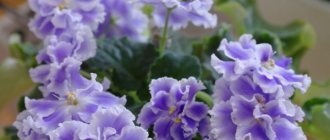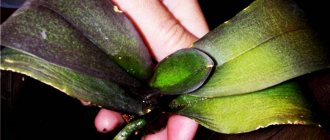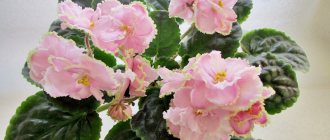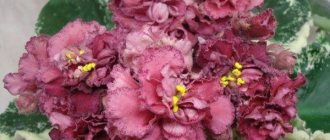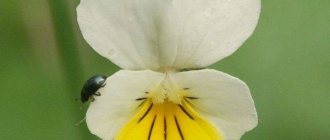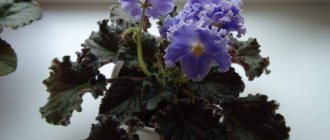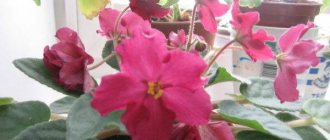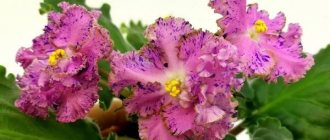Violets are common ornamental plants that are grown mainly indoors.
A wide selection of shades and varieties of this crop allows you to create a mini-flower bed at home. Dear readers!
For you, we have created communities on social networks in which useful articles and interesting ideas are published several times a day! Subscribe and receive useful content in a convenient format! A very popular type of violet is “Blue Fog”. The variety is distinguished by double, simple and fringed flowers.
Description of varieties
“LE-Lilac Rain” is a variegated variety with large double flowers of a soft lilac color and fancy dark purple streaks. The diameter of the flowers can vary from 4.5 to 5.5 cm. The leaves are large, uniformly emerald in color with light beige wavy edges. The sockets are characterized by extraordinary compactness and accuracy. The variety is easy to care for.
“LE-Lilac Tenderness” is an unpretentious variety that produces large and lush lilac-white or white-pink star-shaped flowers. The fleshy, succulent leaves have a slightly pointed tip. The color of the leaves is uniform, emerald or dark green.
“Lilac Charm” is an elegant Saintpaulia with large fringed flowers of a pale lilac color and a thin rich purple edging. A characteristic feature is 3 purple markings located in the center of the flower. The leaves have a regular round shape and slightly wavy edges. The variety is very decorative, characterized by abundant and surprisingly long flowering.
“N-Lilac Smiley” is a beautifully flowering Saintpaulia with large, fringed, amethyst-colored flowers with a bright white edge. The rounded leaves are deep dark green on the outside and reddish on the inside. Peduncles form en masse in the center of a compact rosette.
“RS-Lilac Miracle” is a very spectacular Saintpaulia variety that produces large double flowers of a pale purple color and a lightened edge. The diameter of the flowers can reach 7 centimeters. The leaves are simple, round in shape and uniformly green in color. The diameter of the rosette is about 25 centimeters. The variety is considered very unpretentious, easy to care for and reproduce.
“Lilac Excitement” is an elegant Uzambara violet with very large fringed flowers. The two-color petals combine dark purple and pale purple shades, harmonizing well with the dark emerald foliage. The leaves on the inside are reddish in color.
A specific feature of this variety is lush, abundant and long-lasting flowering.
“PT-Lilac Distance” is an original variety with large single or semi-double flowers. The petals are light amethyst in color with deep purple shading on the wavy edges. The plant forms a neat rosette of variegated leaves with a dark emerald core and a light beige uneven edge.
“Lilac Sand” is a variety of Uzambara violet that has an original and spectacular color. The peculiarity of the plant is its simple pale pink large flowers, dotted with a scattering of small dark purple splashes and framed by an edging of the same shade. The leaves have a classic oval shape and color ranging from pale green to a uniform dark emerald hue.
“Lilac Mist” is an Uzambara violet that forms a beautiful and compact rosette of emerald succulent leaves with jagged edges. During the flowering period, it forms multiple peduncles located in the center of the rosette. The color of the flowers varies from pale amethyst to purple. The ruffled petals have intricate wavy edges. The variety is considered demanding of care; if the rules are not followed, the plant stops blooming.
“Lilac watercolor” is a very spectacular variety, notable for its large, voluminous flowers of pale amethyst color with white spots shifted to the edge or to the center of the petals. The beautiful blurred transition from white to light purple creates a striking contrast against the dark green velvet leaves.
“AV-Purple Elephant” is a relatively young variety that forms a large number of buds during the flowering period. Very large double flowers are collected in thick, voluminous clusters. The color of the petals is a uniform and rich indigo color with an elegant white edging at the edges.
“Lilac Charm” is an unusually beautiful variety, valued by flower growers for its impressive decorative properties. The flowers of this Uzambara violet can be either double or semi-double. The highlight of the variety is the amazing color of the petals - tiny and numerous lilac-raspberry splashes on a delicate pearl pink background. It is noteworthy that closer to the edges of the petals the spray thickens, turning into a beautiful dark lilac edging.
“KO-Lilac Paradise” is an amazingly beautiful variety of Saintpaulias, distinguished by a proportional compact rosette. During the flowering period, a lush cap of flowers of a delicate amethyst color is formed in the center of the rosette. A light snow-white border is allowed on the petals. The leaves have regular rounded outlines, wavy edges and a slightly pointed tip.
Review of purple and lilac varieties of violets
Each person tries to surround himself with objects of a certain color. This color changes depending on age. Florists are people too, and in their collections they prefer the colors and shades that best suit their mood at the moment. Fortunately, even in text mode it is possible to convey the emotional component of a shade, for example, the purity of a snow-white color scheme.
- Lilac Charm. The variety has impressive (relatively) lilac flowers with three dark lilac markings in the middle of the flower. The fringe is a thread of the same dark color, only along the edge of the petals;
- Beloved Daughter. Large, simple plants of a soft lilac lavender hue, with a thick dark purple fringe on the edge of the petals;
- Lilac tenderness LE - classic Uzambara violets with large soft white-lilac or white-pink double flowers, shaped like large stars. Has a standard light socket;
- Unobtrusive Sadness LE. A soft blue plant with slightly darker petal tips. The piquancy of the flower is given by the green ruffle along the edge of the petal. This violet has dark, slightly wavy leaves that shine;
- Currant dessert-EK. Voluminous fluffy and half-double stars with pronounced fringe of an extremely beautiful shade, reminiscent of blackcurrant jam. The foliage is green and velvety.
- EK-Mikhail Lermontov. Just giant lilac Saintpaulias, decorated with fringe. The peduncles are strong, pronounced, the rosette is dark, has an exhibition appearance;
- EK-Turquoise Jellyfish. An interesting fact is that Saintpaulias of this species are truly impressive in size (about 7 cm in diameter). They have a “marine” shade of petals and sky-blue fringed edges. The rosette of these violets is green and compact, consisting of pointed leaves.
- Ward Brown - Impressive violets in terms of size with huge fluffy inflorescences. These Saintpaulias have a rich amethyst (inky color), star shape with slightly curved lilac-bluish edges;
- Velvet Frost are very large, half-double stars with white trim. Saintpaulias of this type are distinguished by lush flowering, a neat base of the petals and green leaves with a ruby-red underside
- Rodeo Roper is a relatively large Saintpaulia with a velvety purple color. The flowers are edged with a contrasting, slightly embossed white border;
- Rodeo Glory - impressive velvet violets with dark purple double flowers that shimmer with black. Saintpaulias of this type have the edges of the petals in the form of an accordion;
- Rebels Centennial Mtar (R. Bunn) – Extremely voluminous dark ruby half-double stars with dark green leaves;
- Optimara Van Gogh (Holtkamp) Huge size violets the color of a concentrated solution of manganese in the shape of a star with green foliage;
- Optimara Hisako is a rather large dark purple or dark cherry pansy with a distinct white center. Very impressive;
- Maria Silvia. Common pansy with a light lilac flower. The ends of the petals of this Saintpaulia are dark lilac, and the foliage is green;
- Lions Pyum-Pudding is a rather original semi-double two-color Saintpaulia of dark plum and red shades. Frilly star.
- Louisiana Lulubai - by normal standards, these are simply huge violets (8-9 cm in diameter). These Saintpaulias come in double, semi-double stars in a soft lavender hue with dark purple flower tips;
- Fisher Lyon. Plum-purple violets with pink stripes, dashes and strokes in the power of fantasy;
- Dixie Doris - Quite large double violets of various shades of lavender with dark endings at the tips of the petals and a greenish-white wavy border;
- Carmival (F. Tinari) - relatively large Saintpaulias of soft purple shades with a green flower base and the same leaves;
- Apache Shadows are dark red-purple plants with wavy flowers. These flowers feature variegated green foliage with pink and white splashes.
- Apache Midnight and Rodeo Glory. Large dark plum flowers with double velvety petals. The inflorescences have black petals with accordion-shaped edges and a thin white edge. Pronounced green foliage;
- Apache Magic - relatively large, semi-double inflorescences of a dark purple hue. They are distinguished by strongly wavy white-green edges. White and pink variegated;
- EK-Baltica. Extremely large semi-double light purple flowers with a wide white border on the petals;
- Rebels and Centenual Star are impressive simple dark semi-double blood violets shaped like stars. They have dark green pointed leaves. They are distinguished by rich and bright flowering;
- Fischer Lyon. A simple dark semi-double flower in a plum pink fantasy style;
- Child's favorite. White half-terry lace Saintpaulia with blue eye, rays and border. The base of the petals is green, flat and somewhat quilted;
- Buckley Blushing is a semi-double or double lavender lace pansy in a purple fantasy style.
Energy of color
Many florists are attracted to lilac plants, the color obtained by merging two colors - red and blue.
The color lilac is considered a living color, but psychological experts believe that its shades cause a feeling of anxiety.
People who have a negative attitude towards lilac shades are extremely lucky in the field of business, because this color is preferred by individuals who avoid a specific answer and do not know how to maintain an open dialogue. The favorite pastime of individuals who prefer lilac tones to others is nostalgia for the past, and this is a direct road to nowhere. Each color is capable of a certain energy and it would be a sin not to use it.
Natalya the contemplator
- Activity: 83k
- Gender: Woman
Natalya contemplator
podokonnik.temadnya.com
How to care?
Uzambara violets are one of the few representatives of the world of ornamental flora that can delight their owner with riotous flowering for a significant part of the year. With proper care and attention, these responsive plants can bloom for up to 10 months, leaving very little time for recovery. In order for Saintpaulias to bloom long and luxuriantly, they need to provide the following conditions:
- sufficient lighting;
- moderate watering regime;
- optimal temperature conditions;
- stable indoor air humidity.
Lighting
Saintpaulias are plants that require abundant but diffused light. A sufficient amount of light during the day provides them with a full process of photosynthesis, thanks to which Uzambara violets can develop and bloom normally.
To increase the duration of flowering, experienced plant growers use additional illumination using phytolamps or fluorescent lighting sources.
Irrigation mode
Uzambara violets are quite tolerant of mild drought, which is less harmful to them than heavy watering. In order for plants to feel good, it is necessary to provide them with regular but moderate watering. Saintpaulias are watered only with settled soft water at the same temperature as the air temperature.
The difference between air and water temperatures should be no more than 5°C.
Air temperature
Saintpaulias are heat-loving plants that are sensitive to drops and changes in air temperature. Experienced gardeners recommend maintaining the temperature in the room where Uzambara violets grow at a stable level of 25°C. A decrease in temperature to 15°C or an increase to 30°C has a detrimental effect on the condition of Saintpaulias. Under such conditions, they stop developing, stop flowering, and in some cases die altogether.
Moderate humidity
In order for Saintpaulias to fully develop and bloom for a long time, they need constant air humidity of 40-50%. To maintain stable humidity, you can keep a special humidifier at home by adjusting its settings. Another way to ensure the necessary air humidity involves installing a bowl or tray with water next to the Saintpaulia. As the water evaporates, it will saturate the air with moisture, which will protect the plants from drying out in hot weather.
It should be noted that a lack of moisture for Saintpaulia is less harmful than excess. If the air humidity is too high or the soil in the pot is waterlogged, Uzambara violets are quickly attacked by rot pathogens. Their fleshy and juicy leaves are able to retain a certain supply of moisture, which is gradually consumed if necessary. However, these plants tolerate excess moisture very painfully, beginning to shed flowers and rot.
In order for the lilac-violet palette of colors to please with its brightness and variety of shades, Saintpaulias need to be provided with fairly abundant but soft lighting, as well as a stable temperature regime.
In winter, to extend the flowering period, plants are illuminated, which allows them to continue full development and formation of buds even with shortened daylight hours.
Diseases and pests
Indoor violet can suffer from the influence of diseases and parasites. The most common enemies of violets remain:
Spider mite. This is a dangerous and quickly spreading insect that loves to feast on plant sap. The lesion can be identified by having a white sticky coating that is concentrated on the surface of the foliage. To eliminate parasites, it is necessary to use drugs such as Fitoverm, Actellik.- Whitefly. This is another dangerous parasite. It occurs when there is low air humidity and high temperature. To combat whitefly, general insecticides are used.
- Mealybug. This is a sucking parasite that loves to feast on violet juice. If the plant is infected, growth stops and then it dies. To combat insects, you need to use a solution of laundry soap.
- Powdery mildew. This is a fungal disease, which can be recognized by a characteristic whitish coating, as in the photo on the right, which damages the leaves. A fungicide is used for control.
- Fusarium. This is a dangerous disease that first affects the roots and leaf blades. If an affected bush is noticed, remove it and treat the soil with a solution of copper sulfate.
Energy of color
The popularization of violets has been in full swing lately. Thanks to the efforts of breeders, more and more people are decorating their homes with Saintpaulia. Beginning collectors are often afraid of failure when purchasing a particular variety.
The lilac violets described in the article are suitable for both beginners and experienced gardeners. What attracts these plants and why are they so popular?
The color range of lilac shades is large. There are not many of them in nature. Therefore, violets bred by creative and extraordinary people help bring harmony to the space of the house. It's warmer and more comfortable with them.
From all the variety of shapes - pansies, stars, bells, bowls, wasps - you can choose the one that suits you. Terry, semi-double, simple, in the form of carnations or scalloped, with a border, fringe - they are equally beautiful and unique.
Lilac violets are fascinating, they have a mysterious energy that makes you kinder and calms you down. Chimeras and Saintpaulias with prints leave no one indifferent.
TOP 10 most popular varieties
AB-Fourth Dimension
The author of the amazingly beautiful violet is Violet Maker (Alexey Tarasov, Moscow).
The flowers are simple stars, the color is dark blue, with dark lilac fantasy, raspberry dusting and rare pink peas. Petals with a dense structure, a white border along the edge. Peduncles are short and strong. The flowering is super abundant and lasts a long time.
The leaves are medium green, slightly toothed, and wavy. The socket is standard.
EK-Tibet
The author of the bright, contrasting variety is Elena Korshunova (Tolyatti). The name is inspired by the pre-dawn views of Tibet.
The flowers are very large, semi-double, the color is in the form of purple-violet spots on the petals, a white eye and a wide snow-white frill.
The petals are wavy and airy. Peduncles are slender and strong. The violet blooms wildly, the bouquet does not fall apart.
The leaves are deep green, round, and medium-sized. The socket is smooth and compact.
EK-Lilac aura
This exquisite, romantic variety is from the collection of breeder Elena Korshunova (Togliatti). Saintpaulia is not capricious, it is easy to tame and care for. In the first flowering it can be upsetting due to the untidy shape of the flowers. Don’t be upset; as you grow up, the Lilac aura will delight you with a first-class bouquet.
The flowers are large, 6 cm each, the color is iridescent lilac, with a purple eye. The fringed petals have a purple edge. It blooms with a beautiful hat.
The leaves are dark green. The rosette is luxurious, exhibition, smooth.
Apache Jewel
The authors of this cute variety are James Calvin and Lenora Munk, famous breeders from Texas, USA. Saintpaulia blooms in bouquets, profusely, for a long time, about 2 months.
The flowers are semi-double and simple, up to 5 cm in size, lilac in color, with a dark eye in the middle. The edges of the petals are dark purple. The shade of the lower petals is lighter.
The leaves are openwork, dark green, variegated along the edge. The socket is smooth, small, standard.
Cosmic Blast
The author of the original variety is Paul Sorano. Saintpaulia is unpretentious, grows quickly, and blooms for a long time. Needs good lighting. Can go into sports.
The flowers are stars, very large, up to 6 cm, dark purple in color. Petals with corrugated edges, a thin white border and bright fuchsia spots. Peduncles are long.
The leaves are variegated, dark green with a white edge. The socket, in case of insufficient lighting, can be pulled upward.
AB-Lace lilac
The author of this amazingly airy variety is Violetvod (Alexey Tarasov, Moscow).
The flowers are large charming stars measuring 6.5 cm, the color is white with lilac shadows. The petals are dense, wavy, edged with a thin green ruffle. In a cool place the border becomes brighter. Peduncles are short, strong, and form a cap.
The leaves are a juicy bright green color, the structure is slightly wavy. Standard socket, compact, neat shape.
Sora Fuzzy Face
Sora Fuzzy Face translates as “fuzzy face” or “fuzzy face.”
The authors of the variety are Barbara Werness and Ruth Bann (B. Werness / R. Bann) - Saintpaulia breeders from Minnesota, USA.
The flowers are charming, discreet pansies in 2 tones: gray-lavender and smoky blue. Petals slightly elongated. Blossoms like a bouquet. Shades can change - lighten or darken. Peduncles are long.
The leaves are green, elongated, slightly variegated. The socket is even, standard.
Lavender mirage
Bright Saintpaulia from the selection of Elena Korshunova (Togliatti). Violet loves natural light and feeding.
The flowers are lovely large double and semi-double, lavender blue with shimmering fantasy purple-blue splashes. It blooms very profusely. The hat is thick and luxurious. It happens that flowers with different shades bloom on one rosette. The peduncles are strong, bearing 5 or more buds.
The leaves are dark green. The rosette is standard, neat, 30 cm. Leaves can lift up.
Lilac tenderness
The author of the luxurious variety is Elena Anatolyevna Lebetskaya (Ukraine). Saintpaulia reproduces well by stepsons and blooms for a long time.
The flowers are lush double stars, large, up to 6 cm, the color is soft lilac. Petals are corrugated. In the first flowering there are few peduncles. They do not form a cap.
The leaves are oblong, light green. The rosette is standard, large, not compact, with few leaves.
AE-Lilac whirlwind
The author of the unusually delicate Saintpaulia is Evgeny Arkhipov (Moscow). The plant does not require special care. Blooms profusely almost all year round.
The flowers are double, airy, white with a pink center and lilac fantasy. Forms a beautiful bouquet. It becomes brighter with each bloom.
The leaves are medium green, wavy, growing in the form of a small, neat, even rosette.
Lilac violets
With border or spots
Stone Flower
The author of the original variety is Konstantin Morev. Saintpaulia grows slowly and loves natural light. Tolerates drought calmly. Forms sports.
The flowers are double and semi-double stars, up to 4 cm, the color is bright, raspberry-violet, the border is yellow-green. Petals have a dense structure.
The leaves are dark green, large, wavy. The socket is standard, symmetrical, even.
Jan – Merilen
The author of the bright, rich variety is Natalya Puminova (Moscow). Saintpaulia pleases with cap blooms, often and in large quantities. Forms sports.
The flowers are large semi-bells, the color is lavender with a soft lilac tint, a bright blue fantasy pattern and a pink eye. The peduncles are strong and tall, holding 3-4 flowers.
The leaves are shiny, bright, light green. The socket is standard, smooth.
Shining stars
The creator of delicate and mysterious violets is Konstantin Morev. Saintpaulias love good watering and sufficient natural light.
The flowers are very large stars up to 6 cm, the color is pastel lilac-violet, there is a white eye in the middle, and a corrugated white border along the edge of the petals.
The flowers last for 2-3 weeks, but are classified as fallout. Peduncles grow tall and may bend slightly.
The leaves are medium green, with white variegation along the edges. The rosette is standard, large, with long petioles.
Summer twilight
The author of the unusually beautiful violet is Konstantin Morev. The variety is unpretentious, blooms for a long time, and at lower temperatures the border on the flowers becomes wider.
Likes watering the soil from above or using a wick. Propagates easily, preferably by cuttings.
The flowers are large, 5-6 cm, double, color is lilac-violet, the eye is white, the edge of the velvet petals has a white border. Peduncles are low and durable.
Sometimes, due to the heaviness of the flowers, they may bend slightly downward.
Leaves are variegated and green. The socket is standard, looks smooth and neat.
Large-flowered
AV-Russian Style
The author of the graceful Saintpaulia is Violetmaker (Alexey Tarasov, Moscow) Not capricious. Does not require special care.
The flowers are large stars with a diameter of up to 7 cm, double, the color is lilac-violet, with a slight flicker, the border is white and green. The petals are dense, elongated, with a waxy structure. It blooms super profusely and forms a beautiful head. Short, strong peduncles hold flowers well.
Leaves are medium green. The socket is neat, looks compact, standard.
Lilac beauty
The author of this marvelous variety is the spouses Boris and Tatyana Makuni. Saintpaulia blooms powerfully, abundantly, for a long time. Does not require special care.
The flowers are large, graceful, fringed, the color is pale lilac, warm, the edging is thin dark purple, dark lilac dots are located closer to the center. Peduncles are strong.
The leaves are round in shape, slightly wavy along the edges, green, slightly elongated. Has a large socket.
The most beautiful varieties of indoor violets
Violets are one of the most popular indoor flowers. There is an incredible number of their varieties. Plants are distinguished by their exquisite beauty and variety of colors. In thematic magazines and the Internet you can see photographs in which the interior of a room, kitchen or loggia looks incredibly cute and cozy thanks to pots of multi-colored violets.
Violet or Saintpaulia
The plant, known to all lovers of indoor floriculture, has other names: Saintpaulia (Saintpaulia in Latin), Usambara violet. From the point of view of scientific classification, Saintpaulia has no relationship with the violet, which grows naturally in the northern hemisphere.
These flowering plants even belong to different families: violets belong to the violet family, and Saintpaulias belong to the genseriaceae. Moreover, the plants are similar in appearance, which explains the use of the same name in colloquial speech.
Gallery: indoor violets (25 photos)
Saintpaulias are perennial herbaceous plants with a fibrous root system. This means that the root system is formed by adventitious roots, and the main root is absent.
The arrangement of Saintpaulia stems varies depending on the type of plant. There are varieties with short stems and basal leaves that form a rosette. An option with long branched stems and several hanging rosettes (ampeloid violets) is also possible.
Saintpaulia leaves can have a round, oval or ovoid outline. The edges may be rounded or jagged. The leaves are flat, wavy or slightly corrugated. There are species with matte and glossy leaf surfaces.
Most varieties of violets have leaves of varying shades of green. The palette can be diluted with olive, cream, golden, ash and pink colors, including in the form of veins at the base or along the edges of the sheet or in the form of a bright mosaic. The reverse side of the leaf is usually painted silver-gray, to which shades of red are sometimes added.
There are types of indoor violets with simple, semi-double and double petal structure. In the first case, the petals in the flower are arranged in one row. With a semi-double structure there are two or three rows, with a double structure there are more than three rows.
Purple varieties
Each person tries to surround himself with objects of a certain color. This color changes depending on age. Florists are people too, and in their collections they prefer the colors and shades that best suit their mood at the moment. Fortunately, even in text mode it is possible to convey the emotional component of a shade, for example, the purity of a snow-white color scheme. We will try to convey the beauty and nobility of lilac violets.
- Lilac Charm. The variety has impressive (relatively) lilac flowers with three dark lilac markings in the middle of the flower. The fringe is a thread of the same dark color, only along the edge of the petals;
- Beloved Daughter. Large, simple plants of a soft lilac lavender hue, with a thick dark purple fringe on the edge of the petals;
- Lilac tenderness LE - classic Uzambara violets with large soft white-lilac or white-pink double flowers, shaped like large stars. Has a standard light socket;
- Unobtrusive Sadness LE. A soft blue plant with slightly darker petal tips. The piquancy of the flower is given by the green ruffle along the edge of the petal. This violet has dark, slightly wavy leaves that shine;
- Currant dessert-EK. Voluminous fluffy and half-double stars with pronounced fringe of an extremely beautiful shade, reminiscent of blackcurrant jam. The foliage is green and velvety.
- EK-Mikhail Lermontov. Just giant lilac Saintpaulias, decorated with fringe. The peduncles are strong, pronounced, the rosette is dark, has an exhibition appearance;
- EK-Turquoise Jellyfish. An interesting fact is that Saintpaulias of this species are truly impressive in size (about 7 cm in diameter). They have a “marine” shade of petals and sky-blue fringed edges. The rosette of these violets is green and compact, consisting of pointed leaves.
- Ward Brown - Impressive violets in terms of size with huge fluffy inflorescences. These Saintpaulias have a rich amethyst (inky color), star shape with slightly curved lilac-bluish edges;
- Velvet Frost are very large, half-double stars with white trim. Saintpaulias of this type are distinguished by lush flowering, a neat base of the petals and green leaves with a ruby-red underside;
- Rodeo Roper is a relatively large Saintpaulia with a velvety purple color. The flowers are edged with a contrasting, slightly embossed white border;
- Rodeo Glory - impressive velvet violets with dark purple double flowers that shimmer with black. Saintpaulias of this type have the edges of the petals in the form of an accordion;
- Rebels Centennial Mtar (R. Bunn) – Extremely voluminous dark ruby half-double stars with dark green leaves;
- Optimara Van Gogh (Holtkamp) Huge size violets the color of a concentrated solution of manganese in the shape of a star with green foliage;
- Optimara Hisako is a rather large dark purple or dark cherry pansy with a distinct white center. Very impressive;
- Maria Silvia. Common pansy with a light lilac flower. The ends of the petals of this Saintpaulia are dark lilac, and the foliage is green;
- Lions Pyum-Pudding is a rather original semi-double two-color Saintpaulia of dark plum and red shades. Frilly star.
- Louisiana Lulubai - by normal standards, these are simply huge violets (8-9 cm in diameter). These Saintpaulias come in double, semi-double stars in a soft lavender hue with dark purple flower tips;
- Fisher Lyon. Plum-purple violets with pink stripes, dashes and strokes in the power of fantasy;
- Dixie Doris - Quite large double violets of various shades of lavender with dark endings at the tips of the petals and a greenish-white wavy border;
- Carmival (F. Tinari) - relatively large Saintpaulias of soft purple shades with a green flower base and the same leaves;
- Apache Shadows are dark red-purple plants with wavy flowers. These flowers feature variegated green foliage with pink and white splashes.
- Apache Midnight and Rodeo Glory. Large dark plum flowers with double velvety petals. The inflorescences have black petals with accordion-shaped edges and a thin white edge. Pronounced green foliage;
- Apache Magic - relatively large, semi-double inflorescences of a dark purple hue. They are distinguished by strongly wavy white-green edges. White and pink variegated;
- EK-Baltica. Extremely large semi-double light purple flowers with a wide white border on the petals;
- Rebels and Centenual Star are impressive simple dark semi-double blood violets shaped like stars. They have dark green pointed leaves. They are distinguished by rich and bright flowering;
- Fischer Lyon. A simple dark semi-double flower in a plum pink fantasy style;
Purple violets: review of varieties with descriptions
Each person tries to surround himself with objects of a certain color. This color changes depending on age. Florists are people too, and in their collections they prefer the colors and shades that best suit their mood at the moment. Fortunately, even in text mode it is possible to convey the emotional component of a shade, for example, the purity of a snow-white color scheme. We will try to convey the beauty and nobility of lilac violets.
- Lilac Charm. The variety has impressive (relatively) lilac flowers with three dark lilac markings in the middle of the flower. The fringe is a thread of the same dark color, only along the edge of the petals;
- Beloved Daughter. Large, simple plants of a soft lilac lavender hue, with a thick dark purple fringe on the edge of the petals;
- Lilac tenderness LE - classic Uzambara violets with large soft white-lilac or white-pink double flowers, shaped like large stars. Has a standard light socket;
- Unobtrusive Sadness LE. A soft blue plant with slightly darker petal tips. The piquancy of the flower is given by the green ruffle along the edge of the petal. This violet has dark, slightly wavy leaves that shine;
- Currant dessert-EK. Voluminous fluffy and half-double stars with pronounced fringe of an extremely beautiful shade, reminiscent of blackcurrant jam. The foliage is green and velvety.
- EK-Mikhail Lermontov. Just giant lilac Saintpaulias, decorated with fringe. The peduncles are strong, pronounced, the rosette is dark, has an exhibition appearance;
- EK-Turquoise Jellyfish. An interesting fact is that Saintpaulias of this species are truly impressive in size (about 7 cm in diameter). They have a “marine” shade of petals and sky-blue fringed edges. The rosette of these violets is green and compact, consisting of pointed leaves.
- Ward Brown - Impressive violets in terms of size with huge fluffy inflorescences. These Saintpaulias have a rich amethyst (inky color), star shape with slightly curved lilac-bluish edges;
- Velvet Frost are very large, half-double stars with white trim. Saintpaulias of this type are distinguished by lush flowering, a neat base of the petals and green leaves with a ruby-red underside;
- Rodeo Roper is a relatively large Saintpaulia with a velvety purple color. The flowers are edged with a contrasting, slightly embossed white border;
- Rodeo Glory - impressive velvet violets with dark purple double flowers that shimmer with black. Saintpaulias of this type have the edges of the petals in the form of an accordion;
- Rebels Centennial Mtar (R. Bunn) – Extremely voluminous dark ruby half-double stars with dark green leaves;
- Optimara Van Gogh (Holtkamp) Huge size violets the color of a concentrated solution of manganese in the shape of a star with green foliage;
- Optimara Hisako is a rather large dark purple or dark cherry pansy with a distinct white center. Very impressive;
- Maria Silvia. Common pansy with a light lilac flower. The ends of the petals of this Saintpaulia are dark lilac, and the foliage is green;
- Lions Pyum-Pudding is a rather original semi-double two-color Saintpaulia of dark plum and red shades. Frilly star.
- Louisiana Lulubai - by normal standards, these are simply huge violets (8-9 cm in diameter). These Saintpaulias come in double, semi-double stars in a soft lavender hue with dark purple flower tips;
- Fisher Lyon. Plum-purple violets with pink stripes, dashes and strokes in the power of fantasy;
- Dixie Doris - Quite large double violets of various shades of lavender with dark endings at the tips of the petals and a greenish-white wavy border;
- Carmival (F. Tinari) - relatively large Saintpaulias of soft purple shades with a green flower base and the same leaves;
- Apache Shadows are dark red-purple plants with wavy flowers. These flowers feature variegated green foliage with pink and white splashes.
- Apache Midnight and Rodeo Glory. Large dark plum flowers with double velvety petals. The inflorescences have black petals with accordion-shaped edges and a thin white edge. Pronounced green foliage;
- Apache Magic - relatively large, semi-double inflorescences of a dark purple hue. They are distinguished by strongly wavy white-green edges. White and pink variegated;
- EK-Baltica. Extremely large semi-double light purple flowers with a wide white border on the petals;
- Rebels and Centenual Star are impressive simple dark semi-double blood violets shaped like stars. They have dark green pointed leaves. They are distinguished by rich and bright flowering;
- Fischer Lyon. A simple dark semi-double flower in a plum pink fantasy style;
- Child's favorite. White half-terry lace Saintpaulia with blue eye, rays and border. The base of the petals is green, flat and somewhat quilted;
- Buckley Blushing is a semi-double or double lavender lace pansy in a purple fantasy style.
Energy of color
Many florists are attracted to lilac plants, the color obtained by merging two colors - red and blue.
The color lilac is considered a living color, but psychological experts believe that its shades cause a feeling of anxiety.
People who have a negative attitude towards lilac shades are extremely lucky in the field of business, because this color is preferred by individuals who avoid a specific answer and do not know how to maintain an open dialogue. The favorite pastime of individuals who prefer lilac tones to others is nostalgia for the past, and this is a direct road to nowhere. Each color is capable of a certain energy and it would be a sin not to use it.
Video “Caring for Violets”
In the video, a woman shares her experience of caring for indoor Saintpaulias. After watching the video, you will learn how often you need to water this plant, what to fertilize it with, and what kind of soil you should plant it in.
myorchidea.ru
Energy of color
Many florists are attracted to lilac plants, the color obtained by merging two colors - red and blue.
The color lilac is considered a living color, but psychological experts believe that its shades cause a feeling of anxiety.
People who have a negative attitude towards lilac shades are extremely lucky in the field of business, because this color is preferred by individuals who avoid a specific answer and do not know how to maintain an open dialogue. The favorite pastime of individuals who prefer lilac tones to others is nostalgia for the past, and this is a direct road to nowhere. Each color is capable of a certain energy and it would be a sin not to use it.
Planting and propagation
This type of plant is best propagated by leaf cuttings. For these purposes, it is necessary to select a strong and healthy leaf from the second lower tier.
To root the resulting cuttings, it is worth using water. The container should be dark, pour water into it, and place activated carbon tablets.
Place the sheet in a container so that only the tip is placed in the liquid. After 2 weeks, roots will form. Now is the time to plant the plant in the ground. If all agrotechnical rules are followed, babies will form on the cuttings within a month.
Leaf cuttings can be rooted directly in the soil. For these purposes, after cutting the plant, plant it in a loose and nutritious substrate.
To make the cutting stable and not fall, you need to secure it using toothpicks.
Cover the top of the sheet with polyethylene. As soon as the babies have formed, the cuttings can be planted in separate pots. Read more about violet propagation
Violet lilac rain photo and description
Lilac, purple and dark purple Uzambara violets amaze the imagination with the richness and depth of their colors. With proper care, these unpretentious indoor plants can charm their owner with lush and abundant blooms most of the time of the year. What varieties of lilac and purple Saintpaulias are popular among gardeners? What are the rules for caring for them?
Description of varieties
“LE-Lilac Rain” is a variegated variety with large double flowers of a soft lilac color and fancy dark purple streaks. The diameter of the flowers can vary from 4.5 to 5.5 cm. The leaves are large, uniformly emerald in color with light beige wavy edges. The sockets are characterized by extraordinary compactness and accuracy. The variety is easy to care for.
“LE-Lilac Tenderness” is an unpretentious variety that produces large and lush lilac-white or white-pink star-shaped flowers. The fleshy, succulent leaves have a slightly pointed tip. The color of the leaves is uniform, emerald or dark green.
“Lilac Charm” is an elegant Saintpaulia with large fringed flowers of a pale lilac color and a thin rich purple edging. A characteristic feature is 3 purple markings located in the center of the flower. The leaves have a regular round shape and slightly wavy edges. The variety is very decorative, characterized by abundant and surprisingly long flowering.
“N-Lilac Smiley” is a beautifully flowering Saintpaulia with large, fringed, amethyst-colored flowers with a bright white edge. The rounded leaves are deep dark green on the outside and reddish on the inside. Peduncles form en masse in the center of a compact rosette.
“RS-Lilac Miracle” is a very spectacular Saintpaulia variety that produces large double flowers of a pale purple color and a lightened edge. The diameter of the flowers can reach 7 centimeters. The leaves are simple, round in shape and uniformly green in color. The diameter of the rosette is about 25 centimeters. The variety is considered very unpretentious, easy to care for and reproduce.
“Lilac Excitement” is an elegant Uzambara violet with very large fringed flowers. The two-color petals combine dark purple and pale purple shades, harmonizing well with the dark emerald foliage. The leaves on the inside are reddish in color.
A specific feature of this variety is lush, abundant and long-lasting flowering.
“PT-Lilac Distance” is an original variety with large single or semi-double flowers. The petals are light amethyst in color with deep purple shading on the wavy edges. The plant forms a neat rosette of variegated leaves with a dark emerald core and a light beige uneven edge.
“Lilac Sand” is a variety of Uzambara violet that has an original and spectacular color. The peculiarity of the plant is its simple pale pink large flowers, dotted with a scattering of small dark purple splashes and framed by an edging of the same shade. The leaves have a classic oval shape and color ranging from pale green to a uniform dark emerald hue.
“Lilac Mist” is an Uzambara violet that forms a beautiful and compact rosette of emerald succulent leaves with jagged edges. During the flowering period, it forms multiple peduncles located in the center of the rosette. The color of the flowers varies from pale amethyst to purple. The ruffled petals have intricate wavy edges. The variety is considered demanding of care; if the rules are not followed, the plant stops blooming.
“Lilac watercolor” is a very spectacular variety, notable for its large, voluminous flowers of pale amethyst color with white spots shifted to the edge or to the center of the petals. The beautiful blurred transition from white to light purple creates a striking contrast against the dark green velvet leaves.
“AV-Purple Elephant” is a relatively young variety that forms a large number of buds during the flowering period. Very large double flowers are collected in thick, voluminous clusters. The color of the petals is a uniform and rich indigo color with an elegant white edging at the edges.
“Lilac Charm” is an unusually beautiful variety, valued by flower growers for its impressive decorative properties. The flowers of this Uzambara violet can be either double or semi-double. The highlight of the variety is the amazing color of the petals - tiny and numerous lilac-raspberry splashes on a delicate pearl pink background. It is noteworthy that closer to the edges of the petals the spray thickens, turning into a beautiful dark lilac edging.
“KO-Lilac Paradise” is an amazingly beautiful variety of Saintpaulias, distinguished by a proportional compact rosette. During the flowering period, a lush cap of flowers of a delicate amethyst color is formed in the center of the rosette. A light snow-white border is allowed on the petals. The leaves have regular rounded outlines, wavy edges and a slightly pointed tip.
Violet violet: names of varieties and description
Violet Violet: photo
- “LE - Lilac Rain” is a plant with large fuzzy buds of a creamy pastel purple color, shimmering with a dark purple color. The size of the inflorescences can reach from forty-five to fifty-five millimeters. The leaves are large, dark green with a yellow wavy edge. The rosettes are neat, located close to each other. This species is not squeamish in care.
- “Lilac Delight” is a charming plant with large, fuzzy buds of a light lilac color with the addition of neat purple stripes. The highlight is that there are three purple spots in the middle of the bud. The leaves are oval and wavy. Decorative species, long-term flowering.
- “N - Lilac Smiley” is a very beautiful plant, with large fleecy buds of lilac color with a snow-white outline. The leaves are oval, emerald green, brown on the underside. The inflorescence is located closer to the center.
- “RS – Lilac Miracle” is a charming type of violet, large buds with pastel purple hairs with a white edge. The size of the buds develops up to seven centimeters. The leaves are ordinary, oval, green in color. The size of the rosette reaches up to twenty-five centimeters. The plant is easy to care for, not squeamish.
- "Lilac Excitement" is a charming plant with large, fuzzy buds. The petals are of two colors, either dark purple or pastel purple. The leaves are dark green in color. The underside of the leaves is brown. The highlight of the plant is its wide, regular and long inflorescence.
- “PT-Lilac distance” is a beautiful flower with large fuzzy buds of pastel lilac color, the center is purple. A compact rosette of dark green leaves with yellow lining around the edges.
- “Lilac Sand” is a plant with a surprisingly bright shade of buds. The highlight of the flower is the usual creamy pinkish large inflorescences, on which there are splashes in the form of a purple pattern, the leaves are light or dark green.
- “Lilac mist” - Saintpaulia, a neat rosette of a plant, consists of a cluster of dark green leaves with ribbed edges. When the plant blooms, all the buds accumulate in the center. The color of the plant can range from light lilac to purple. Petals with villi, curl. The plant is fastidious in care, so it needs to be carefully looked after; if this is not done, the plant simply stops blooming.
- “Lilac watercolor” is a charming plant with large buds of a light lilac color with a snow-white pattern along the edges and in the middle of the flowers. The leaves are emerald in color, such a contrast in the plant looks very impressive.
- “AB – Purple Elephant” is a recently known plant species; its inflorescence collects a large number of flowers. The flowers are large in size with lilac-colored fibers with a snow-white edging along the edges.
- “Lilac charm” is a plant of unusual beauty; gardeners love this plant very much for its beauty and attractiveness. The buds have fibers and are sometimes smooth. The color of the buds is in the form of a pattern of multi-colored splashes of pinkish, lilac shades on a cream color. The outline is purple.
- “KO – Lilac Paradise” is a charming plant, its rosette is neat. When the plant blooms, a creamy lilac cap forms in the middle. The petals are white. The edging is also light. The leaves are oval-shaped, wavy, elongated, green.
How to care?
Uzambara violets are one of the few representatives of the world of ornamental flora that can delight their owner with riotous flowering for a significant part of the year. With proper care and attention, these responsive plants can bloom for up to 10 months, leaving very little time for recovery. In order for Saintpaulias to bloom long and luxuriantly, they need to provide the following conditions:
moderate watering regime;
Lighting
Saintpaulias are plants that require abundant but diffused light. A sufficient amount of light during the day provides them with a full process of photosynthesis, thanks to which Uzambara violets can develop and bloom normally.
To increase the duration of flowering, experienced plant growers use additional illumination using phytolamps or fluorescent lighting sources.
Irrigation mode
Uzambara violets are quite tolerant of mild drought, which is less harmful to them than heavy watering. In order for plants to feel good, it is necessary to provide them with regular but moderate watering. Saintpaulias are watered only with settled soft water at the same temperature as the air temperature.
The difference between air and water temperatures should be no more than 5°C.
Air temperature
Saintpaulias are heat-loving plants that are sensitive to drops and changes in air temperature. Experienced gardeners recommend maintaining the temperature in the room where Uzambara violets grow at a stable level of 25°C. A decrease in temperature to 15°C or an increase to 30°C has a detrimental effect on the condition of Saintpaulias. Under such conditions, they stop developing, stop flowering, and in some cases die altogether.
Care
Despite the fact that the violet variety in question is unpretentious in care, you still need to follow some recommendations.
Watering
This process is very important for violets, since it is high-quality watering that contributes to the rapid development of violets.
For irrigation, use settled water , and its temperature should be slightly above room temperature.
For watering, use a watering can with a thin stand. In this way, moisture can be prevented from penetrating the flower.
Moisturize 2 times a week. The main thing here is not to overdo it, as excess moisture will lead to rotting of the roots. This can be determined by the presence of brown spots on the leaves.
Transfer
It is worth replanting the blue flower in the fall. Then the plant will be able to adapt to winter frosts. During transplantation, you need to be careful not to damage the rhizome.
Fertilizer and feeding
For the Blue Fog variety, it is necessary to use liquid organic matter and tablets. Apply fertilizing to the soil during the flowering phase, and a second time as needed.
